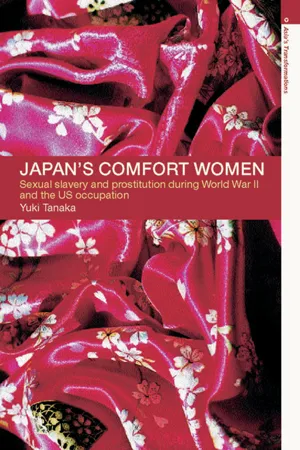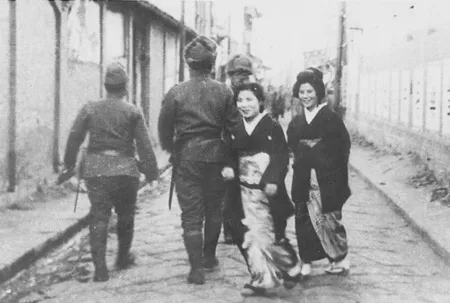![]()
1The origins of the comfort
women system
The initial establishment of comfort stations
Exactly when the Japanese Imperial forces first set up ianjo (comfort stations) — military brothels — for the exclusive use of their soldiers and officers is still unknown. This is because a vast number of relevant official records were destroyed immediately after Japan announced its surrender in August 1945. However, a number of official Japanese documents related to this issue have been unearthed in the last several years. Information available in these newly discovered documents strongly suggests that the first Japanese military brothels for the exclusive use of troops and officers were those set up for the Japanese Navy in Shanghai, during the so-called “Shanghai Incident” in 1932.
On September 18, 1931, Japanese forces blew up the railway at Lake Liu (near Mukden in southern Manchuria), then claimed that Chinese forces had destroyed the railway. The Kwantung (Kantō) Army of the Japanese Imperial forces plotted this “sabotage” in order to provide a pretext for the invasion of northeast China. This marked the beginning of the so-called “Manchurian Incident.” As Chinese forces avoided a major confrontation with the Japanese in this region, Japanese forces managed to occupy this part of China within a relatively short period. In January the following year, Japanese forces entered into an armed conflict with Chinese forces in Shanghai. The Japanese later named this military clash “the first Shanghai Incident.” This “incident” was also plotted by the Kwantung Army, in order to divert the attention of Western nations from Japan’s plan to establish the Manchuguo puppet state.
The Japanese Navy dispatched to Shanghai first set up military brothels in that city. According to a report prepared in late 1938 by the Japanese Consulate-General’s office in Shanghai, “as soon as the Shanghai Incident occurred, some staff from our military forces stationed here established the navy ianjo (in reality, licensed houses) to serve as leisure facilities for its members, which continue to be operated since then.”1
Before this time, the Chinese government had made efforts to abolish prostitution in Shanghai. In 1929, the operation of the Japanese brothels in this city was officially banned, as the Japanese Ministry of Foreign Affairs was placed in the difficult situation of co-operating with the Chinese authorities. However, Japanese
Plate 1.1 Japanese comfort women walking in the street where Japanese soldiers are strolling. The exact location is unknown, although it is somewhere in north China. The photo was taken in March 1939.
Source: Mainichi Shimbun
prostitutes were employed as “waitresses” at Japanese restaurants in the city, and continued their business. Thus, although Japanese brothels existed in Shanghai well before the Shanghai Incident, they were privately operated brothels for Japanese residents and visitors, not exclusive military brothels.2
Probably only a few Japanese Navy brothels were set up at the time of the Shanghai Incident. The report prepared by the Japanese Consulate-General’s office in Shanghai (mentioned above) recorded the existence of ten brothels in late 1936, with 102 Japanese and 29 Korean women employed as “prostitutes.” Seven of these houses were navy brothels, and three others were so-called “Japanese restaurants.” According to the same report, these seven brothels were for the exclusive use of members of the Japanese Navy, and civilians were not allowed to enter the premises. Twice a week, “prostitutes” at these houses received medical examinations conducted by a venereal disease (VD) specialist, accompanied by a member of the naval force and a Japanese police officer attached to the Consulate-General’s office.3 In other words, these navy brothels seemed to be established primarily as a VD-prevention method, and operated under the close supervision of navy authorities as well as the Consulate-General’s office (i.e. Japan’s Ministry of Foreign Affairs).
Having had this experience in military-controlled prostitution in the early 1930s, the Japanese Navy started sending comfort women to China soon after the Sino-Japanese War began in 1937. For example, on November 30, 1937, the Yawata police station in Fukuoka prefecture (Kyushu) granted permission to two Korean women to travel to Shanghai. The women, residents of the same prefecture, were to work at one of the navy brothels in Shanghai.4 This evidence and other available information indicates that Korean comfort women sent to China early in the Asia-Pacific War were residents of Japan, mostly indentured workers, rather than coming directly from Korea.
The Japanese Army followed the navy’s precedent and set up their own “brothels” in Shanghai in March 1932. This was initiated by General Okamura Yasuji, the Deputy Chief of Staff of the Shanghai Expeditionary Army. According to his memoirs, the General decided to set up similar facilities to the navy, in order to prevent further rape of Chinese civilians by Japanese soldiers — a serious problem during the Shanghai Incident. General Okamura requested the Governor of Nagasaki prefecture (Kyushu) to send a group of comfort women to Shanghai.5 His choice of Nagasaki as a recruiting centre for comfort women was probably based on its historical background. Many so-called karayuki-san ( Japanese prostitutes working at overseas brothels) of poor family background in Nagasaki had previously been sold by their parents to procurers and sent to various places in the Asia-Pacific region.6 It is clear from Okamura’s private record that the army intended to use Japanese professional women, rather than Koreans, as comfort women at this stage.
It is interesting to note that the army’s explicit purpose in setting up such facilities in Shanghai was not only the prevention of VD but also the prevention of rape committed by their own soldiers. The diary of another senior staff officer in Shanghai, Lieutenant-General Okabe Naozaburō, further confirms this point. On March 14, 1932, he wrote:
Recently I have heard a lot of scandalous stories, including that some our soldiers wander around seeking women. Such a phenomenon is hard to prevent as fighting becomes less frequent. Therefore the establishment of appropriate facilities must be accepted as a good cause and should be promoted. In consideration of our soldiers’ sexual problems, we have decided to introduce various measures. Lieutenant-Colonel Nagami Toshinori is now responsible for this task.7
From these records, it is clear that the establishment of army comfort stations was initiated by top-ranking officers of the Japanese forces stationed in Shanghai. The actual plan was carried out by senior staff officers.
Why did the senior leaders of Japanese forces in Shanghai quickly introduce military-controlled prostitution? Undoubtedly, one important factor was the bitter experience of Japanese forces during the so-called “Siberian Expedition,” between 1918 and 1922. Okamura, although only for a short period, served as the commander of the 14th Infantry Regiment which participated in this war against the Russians. Okabe was well known amongst Japanese military leaders as a Russian specialist, and he was an officer attached to the Special (i.e. secret) Service Agency in the Vladivostok headquarters during this expedition. For the majority of the Japanese troops sent to Siberia, the mission of this military expedition was unclear, and the soldiers’ morale was relatively low from the beginning. The discipline of these troops was also slack. Widespread looting and rape by Japanese troops on Russian soil gravely concerned Japanese military leaders.8
The Japanese commanders in Siberia were also troubled by the high VD rate amongst their troops. According to the official record, 1,109 soldiers were treated as VD patients between August 1918 and October 1920. The true figure was probably much higher. Even when the official figures are compared with 1,399 deaths and 1,528 casualties during the same period, one realizes how seriously VD affected the combat strength of the troops. In order to tackle this problem, the kempeitai (the Japanese military police force) was authorized to regulate private prostitution in Sakhalin and to force the prostitutes to have periodical medical examinations.9 It can be said, therefore, that the establishment of military brothels in Shanghai in the 1930s, by both the Japanese Navy and Army, was a natural development from regulated prostitution in Siberia.
An official document confirms that a comfort station was set up in northeast China in April 1933, more than a year after the establishment of military brothels in Shanghai. On April 10, 1933, the Kwantung Army crossed the Changcheng Border, starting an invasion towards the east of China. The document, from the 14th Mixed Infantry Brigade of the Kwantung Army stationed in Pingquan, provides some evidence. According to some of the reports on sanitary affairs issued every ten days by the Brigade headquarters, local Chinese brothels were placed off-limits to Japanese soldiers, because of suspected high VD rates among the prostitutes working there. Instead, a station called the “Hygienic Facility for Prevention of Epidemics” was set up, housing 35 Korean women and three Japanese women. Medical examinations of these women were conducted by a Brigade medical officer. At the same time, two condoms were distributed to each soldier (a total of 15,528 condoms). The soldiers were instructed on how to use condoms and to apply prophylactic chemicals immediately after returning from this station. Although the word “ianjo” was not used in this report, there is no doubt this was indeed a comfort station.10
It is not hard to imagine that with the small number of newly arrived comfort women, this “Hygienic Facility” could not satisfy the demand of all 7,764 soldiers from the Brigade. Various units soon requested the Brigade headquarters to remove the off-limits placed on local brothels. As a result, after conducting medical examinations of prostitutes in these private brothels, the headquarters permitted soldiers to use these houses as well. However, it seems that senior headquarters staff were not in fact impressed by the results of these medical examinations, which showed a VD rate of 30 percent.11
Very few official documents have so far been found which refer to the establishment of comfort stations in northeast China at this time. However, this does not necessarily mean that there were only a few such stations attached to Japanese forces in this region. On the contrary, the following statement of Dr. Nakayama Tadanao (Director of the Nakayama Institute of Chinese Medicine) indicates that many comfort women were already being transported to this area of China at this early stage of the Asia-Pacific War. In June 1933, Dr. Nakayama
Plate 1.2 A Japanese officer standing by a large number of corpses, victims of the Nanjing Massacre.
Source: Ōtsuki Shoten
was on the way from Jinzhou to Chengde (the capital of Rehe Province), and tried to secure a seat in an army plane:
After I came to Manchuria, especially here in Chengde, I truly realized that Joshi-gun (Young Women’s Corps) is not just a word of fantasy, and that they were a part of the military forces, indeed a military force itself. I was told by a commander in Jinzhou that the women will be put on a plane as a priority, as they are necessary goods. Wherever Japanese forces advance to, the first thing senior officers consider is the importation of Joshi-gun. Thanks to these women, the Japanese troops do not rape Chinese women. These women are therefore not just prostitutes!12
As we will see later, there was no basis to Dr. Nakayama’s belief that the provision of comfort women would prevent rapes of Chinese civilians by Japanese soldiers.
A rapid increase in comfort stations after the “Rape of Nanjing”
Although it seems that a number of comfort stations were set up in Shanghai as well as northeast China in early 1930s, Japanese forces adopted the military comfort women system as a general policy from late 1937. As a result, a large number of women were mobilized as comfort women.
In July 1937, Japan started a full-scale invasion of China. By early 1938, the number of Japanese troops stationed in China (including Manchuguo) incre...


